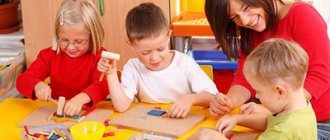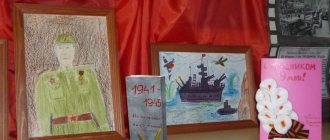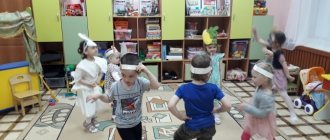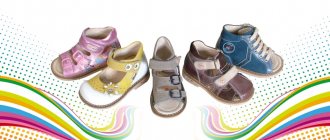<…1. Introductory part. Organizational moment (2 min.). Children enter the hall. Greet guests. Teacher: - Guys, do you like to travel? (children's answers) - What can you go on a journey with? (children's answers) - Is it possible to walk? (children's answers) - I suggest you go to a magical, fairy-tale clearing... - Oh, guys, look: someone's footprints? Whose tracks do you think these are? Let's see where they take us? Children follow in the footsteps of the teacher. The children go into the hall, there they find a felt boot lying in a “snowdrift”. Teacher: - Here is our magical clearing. Oh, guys, look what it is here in the snowdrift? (children's answers) - Which of you guys have felt boots? Maybe some of you have lost it? (children's answers) - Then let's leave it here, suddenly the one who lost it will return (children's answers).
- Main part.
Listening to K.I. Chukovsky’s poem “The Miracle Tree” (5–7 min.). - Guys, I already told you that a fairy tale awaits you here. So, this good fairy tale is the poem “The Miracle of a Tree,” and it was written by Korney Ivanovich Chukovsky (portrait of K. I. Chukovsky, slide 1). – Now, guys, sit down more comfortably, now we will listen to this poem performed by the author himself, Korney Ivanovich Chukovsky. Children sit on chairs and listen. (Slide 2, 3) - Guys, why was the tree in the fairy tale that we listened to called wonderful, a miracle - a tree? (slide 4) (children's answers) - Guys, you know that shoes are seasonal. Tell me, what is the name of the shoes we wear in the summer? (in one word) In autumn? In winter? (children's answers) - Guys, guess the riddle? Not shoes, not boots, But feet wear them too, We run in them in winter, In the morning - to kindergarten, in the afternoon - home! Children: Valenki (slide 5). Teacher: - Guys, Dasha knows a poem about felt boots, and now she’ll tell us about it. The child recites a poem. Teacher: - Guys, what do you know about felt boots? (children's answers) - Do you know how felt boots are made? Do you want me to tell you? (Children's answers) Show a presentation about felt boots, their properties, stages of production, decor options (3 min.). (slide 6) Valenki is a simple Russian word. From time immemorial they have been an integral part of Russian costume, Russian winter. The felt boots are rustic, but also durable, reliable, and will not let you down in difficult times! Valenki are comfortable and healing shoes. In felt boots we are not afraid of the most severe frosts. Felt boots are soft winter boots made of wool (slide 7). Felting a felt boot means rolling the wool into a certain shape - the shape of a felt boot. But felt boots are produced only in Russia, and the tradition of this craft is passed on from generation to generation. (slide Valenki are the only shoes made entirely from natural materials: wool is simply sheared from sheep and processed - felted. And felted like this: they treated the wool with boiling water, steam, smoke, knocked it into a total mass (slide 9) - felt - and rolled it - first on the table (slide 10), and then on a block of the required size... (slide 11) Felt boots of different colors were rolled from sheep's wool: black, gray and white (slide 12). (slide 13) Nowadays, very often craftsmen decorate felt boots with various appliqués, with embroidery, they paint felt boots in different colors. Look how different the felt boots are, how unusual they are... And in addition to the ordinary felt boots that you and I wear, craftsmen make decorative felt boots, souvenir ones. - Guys, let's decorate that felt boot that you and I found , I think that the owner of this felt boot will not mind. A surprise moment (3 min.). The children notice that the felt boot has disappeared, and in its place a tree has grown in a snowdrift. The teacher pulls the cape off the crown of the tree. The felt boots are hanging on it (paper templates made of multi-colored cardboard). Teacher: - Guys, our clearing really turned out to be magical! In the place where the felt boot lay, a tree grew! Look, the felt boots are ripe on our tree! What a tree, a wonderful tree!!! – Tell me, who usually sits on tree branches instead of felt boots in winter? (children's answers) - Guys, do you want to decorate our felt boots with bright appliqués? (children's answers) -Let's decorate the felt boots with applications - birds: bullfinches and titmice. Teacher: - Russians love to wear felt boots in the winter. In the cold, we can create a miracle out of felt boots - a fairy tale. And for this we need to go to the workshop. Will you help me? Choose one felt boot for yourself and take it with you. Children choose a template to work with. Performing the application (15 min). Children go to their work places and sit down. Educator: -Before we get to work, let's remember what felt boots are made of? (Children's answers). – Yes, that’s right, to make felt boots you need sheep’s wool. I have regular wool, and I have dyed wool. Look, touch, what is she like? – I made these little souvenir felt boots from this wool. (The teacher shows small felt boots, felted with his own hands). (Children's answers). – What else do you think wool is used for? (children's answers) - Yes, in addition to felt boots, yarn and threads are made from wool (children's answers). – So for our applique we will need pompoms made of wool yarn. Choose any pompom you like. Take it in your hands, touch it. Do you feel warm? (children's answers) - Tell me, what do these fluffy balls look like? Do they look like birds? - This is the kind of felt boot you should get. (Showing a finished sample for making an application). You have everything you need for work on your tables. (Let's think about how we can make a bird out of these parts?) Now I will show you the sequence of work. To begin with, let’s draw (with a felt-tip pen) a twig on our felt boots on which the bird will sit. Will those with a yellow pompom do it? (titmouse), and those with red ones? (bullfinch). To make the base of our bird, we need a black rectangle, we must turn it into an oval, cutting off and rounding all the corners (the teacher shows the process of rounding the corners, reminds us that the scissors must be held correctly). Then we coat the resulting oval (base) with glue and glue it onto the felt boot template. From a small rectangle, cutting it diagonally, we get a tail and a wing. At the triangle-wing, we round off two corners to form a droplet. Glue all the missing parts (tail, wing, beak and eye). We glue the finished white piece of a smaller size onto the wing. To apply glue to parts, we use oilcloths and a napkin to remove excess glue. Apply glue to the belly of the resulting bird and attach a pompom. (You can use cotton wool to stick a snowball on the branches.) Children do the work. The teacher gives advice, approaches those who have difficulty doing the work, and helps. - And now, in order for our birds to straighten their feathers, we need to warm them up with our warmth, let’s breathe on them like this, stroke them with our palms. - And before we hang them back on the tree, you and I need to find a pair for our felt boots. The children get up and find a couple. Teacher: - Now let’s hang each pair of felt boots on its own branch. Children approach the tree and hang their felt boots on the tree.
- Guys, I already told you that a fairy tale awaits you here. So, this good fairy tale is the poem “The Miracle of a Tree,” and it was written by Korney Ivanovich Chukovsky (portrait of K. I. Chukovsky, slide 1). – Now, guys, sit down more comfortably, now we will listen to this poem performed by the author himself, Korney Ivanovich Chukovsky. Children sit on chairs and listen. (Slide 2, 3) - Guys, why was the tree in the fairy tale that we listened to called wonderful, a miracle - a tree? (slide 4) (children's answers) - Guys, you know that shoes are seasonal. Tell me, what is the name of the shoes we wear in the summer? (in one word) In autumn? In winter? (children's answers) - Guys, guess the riddle? Not shoes, not boots, But feet wear them too, We run in them in winter, In the morning - to kindergarten, in the afternoon - home! Children: Valenki (slide 5). Teacher: - Guys, Dasha knows a poem about felt boots, and now she’ll tell us about it. The child recites a poem. Teacher: - Guys, what do you know about felt boots? (children's answers) - Do you know how felt boots are made? Do you want me to tell you? (Children's answers) Show a presentation about felt boots, their properties, stages of production, decor options (3 min.). (slide 6) Valenki is a simple Russian word. From time immemorial they have been an integral part of Russian costume, Russian winter. The felt boots are rustic, but also durable, reliable, and will not let you down in difficult times! Valenki are comfortable and healing shoes. In felt boots we are not afraid of the most severe frosts. Felt boots are soft winter boots made of wool (slide 7). Felting a felt boot means rolling the wool into a certain shape - the shape of a felt boot. But felt boots are produced only in Russia, and the tradition of this craft is passed on from generation to generation. (slide Valenki are the only shoes made entirely from natural materials: wool is simply sheared from sheep and processed - felted. And felted like this: they treated the wool with boiling water, steam, smoke, knocked it into a total mass (slide 9) - felt - and rolled it - first on the table (slide 10), and then on a block of the required size... (slide 11) Felt boots of different colors were rolled from sheep's wool: black, gray and white (slide 12). (slide 13) Nowadays, very often craftsmen decorate felt boots with various appliqués, with embroidery, they paint felt boots in different colors. Look how different the felt boots are, how unusual they are... And in addition to the ordinary felt boots that you and I wear, craftsmen make decorative felt boots, souvenir ones. - Guys, let's decorate that felt boot that you and I found , I think that the owner of this felt boot will not mind. A surprise moment (3 min.). The children notice that the felt boot has disappeared, and in its place a tree has grown in a snowdrift. The teacher pulls the cape off the crown of the tree. The felt boots are hanging on it (paper templates made of multi-colored cardboard). Teacher: - Guys, our clearing really turned out to be magical! In the place where the felt boot lay, a tree grew! Look, the felt boots are ripe on our tree! What a tree, a wonderful tree!!! – Tell me, who usually sits on tree branches instead of felt boots in winter? (children's answers) - Guys, do you want to decorate our felt boots with bright appliqués? (children's answers) -Let's decorate the felt boots with applications - birds: bullfinches and titmice. Teacher: - Russians love to wear felt boots in the winter. In the cold, we can create a miracle out of felt boots - a fairy tale. And for this we need to go to the workshop. Will you help me? Choose one felt boot for yourself and take it with you. Children choose a template to work with. Performing the application (15 min). Children go to their work places and sit down. Educator: -Before we get to work, let's remember what felt boots are made of? (Children's answers). – Yes, that’s right, to make felt boots you need sheep’s wool. I have regular wool, and I have dyed wool. Look, touch, what is she like? – I made these little souvenir felt boots from this wool. (The teacher shows small felt boots, felted with his own hands). (Children's answers). – What else do you think wool is used for? (children's answers) - Yes, in addition to felt boots, yarn and threads are made from wool (children's answers). – So for our applique we will need pompoms made of wool yarn. Choose any pompom you like. Take it in your hands, touch it. Do you feel warm? (children's answers) - Tell me, what do these fluffy balls look like? Do they look like birds? - This is the kind of felt boot you should get. (Showing a finished sample for making an application). You have everything you need for work on your tables. (Let's think about how we can make a bird out of these parts?) Now I will show you the sequence of work. To begin with, let’s draw (with a felt-tip pen) a twig on our felt boots on which the bird will sit. Will those with a yellow pompom do it? (titmouse), and those with red ones? (bullfinch). To make the base of our bird, we need a black rectangle, we must turn it into an oval, cutting off and rounding all the corners (the teacher shows the process of rounding the corners, reminds us that the scissors must be held correctly). Then we coat the resulting oval (base) with glue and glue it onto the felt boot template. From a small rectangle, cutting it diagonally, we get a tail and a wing. At the triangle-wing, we round off two corners to form a droplet. Glue all the missing parts (tail, wing, beak and eye). We glue the finished white piece of a smaller size onto the wing. To apply glue to parts, we use oilcloths and a napkin to remove excess glue. Apply glue to the belly of the resulting bird and attach a pompom. (You can use cotton wool to stick a snowball on the branches.) Children do the work. The teacher gives advice, approaches those who have difficulty doing the work, and helps. - And now, in order for our birds to straighten their feathers, we need to warm them up with our warmth, let’s breathe on them like this, stroke them with our palms. - And before we hang them back on the tree, you and I need to find a pair for our felt boots. The children get up and find a couple. Teacher: - Now let’s hang each pair of felt boots on its own branch. Children approach the tree and hang their felt boots on the tree.
- Final part (5 min.)
The teacher offers to relax after work. - Guys, we have worked hard, it’s time to rest. Let's get into a round dance. The Russian folk song “Like thin ice” sounds for you. A round dance is performed: “Like on thin ice.” During the round dance, Vanyushka (a student from the preparatory group) appears on a horse and wearing only felt boots, falls, and is lifted up by two girls. Teacher: -Oh, Vanyusha, aren’t you hurt? Vanyusha: No! I fell for fun, I wanted to make you laugh a little! - Guys, have you seen my felt boots here, have I lost it? (children's answers) Teacher: -Guys, tell Ivanushka what happened to his felt boots? (Children's answers) - In our magical clearing, instead of your felt boots, a miracle tree grew, as in the fairy tale of Korney Ivanovich Chukovsky, and on it the felt boots ripened. Look how our guys decorated them. - Guys, let's give Vanya a pair of new felt boots? (children's answers) - Choose, Ivanushka, which ones you liked! Vanya chooses felt boots and thanks the guys. Vanya: - Oh, thanks, guys, you helped out! And I have gifts for you (takes out sweet cockerels on sticks from a bag and distributes them to the children). When I was galloping towards you, I saw another miracle tree on the way, would you like to see it? Then everything is behind me!..>
Lesson summary on application in the middle group
Topic: Clothes.
Goal: To form in the child an active interest in the world around him and provide the child with the opportunity to reflect reality, form purposeful activities and develop general intellectual skills.
Tasks. Educational: Learn how to apply appliqué according to an image, gluing objects of various shapes, sizes and colors. Continue to develop in children a positive attitude towards performing the application. Learn to name the external characteristics of objects. Learn to navigate on a sheet of paper. Educational: Cultivate interest in classes. To cultivate moral qualities (careful attitude towards crafts, hard work), independence. To foster an evaluative attitude in children towards their own work and the work of their peers. Corrective and developmental: Develop the ability to correctly position applique blanks and follow the sequence of gluing them.
Record spatial representations in speech utterances. Learn to analyze a sample. Develop fine motor skills. Correct the personal qualities of the emotional-volitional sphere of children (self-control, perseverance, ability to express their feelings). Preparatory part. 1. Organizational stage. 2. Introductory conversation. Q: We have guests today. Let's say hello to them. D: Hello! Q: Look who else came to visit us? D: Doll. Q: Let's play with her and see how she's dressed. D: Yes. Q: What time of year is it outside now? D: Winter. Q: Is it warm or cold outside? D: It's cold. Q: What should we wear for her so that she doesn’t freeze outside? D: On the legs - pants, on the body - a jacket, on the head - a hat, on the neck - a scarf, on the hands - mittens. Q: Well done! Right! Children go out one by one and put on an item of clothing. Q: How can you call all these things in one word? D: Clothes! B: Okay. Well done!!!
Main part 1. Q: Today we have a lesson “Applique”. For the lesson we will need: glue, blanks of clothes made of colored paper, a doll glued to paper, napkins for hands. Q: Show me the glue. D: Show glue. Q: Show clothes for the dolls. Find a jacket on your table. D: The children show the jacket. Q: Find the hat. D: Children show the cap. Q: Find a scarf. D: They find and show the scarf. Q: Now let's find the mittens. D: They find mittens. B: Well done. How can all these objects be called in one word? D: Clothes! B: Okay! Right!
2. Analysis of the image object (sample) by shape, size, structure, color and position in space. Q: What is this shown in my picture? D: Clothes! Q: Why do we need it? D: To wear in winter when it’s cold. Q: Name... What do we wear first, and what then? D: They call it clothes. 3. Determining the sequence of application execution. Q: Look at the picture. We will dress a boy and a girl and begin making our appliqué in the following sequence. Q: First we will put on a jacket for our doll, then we will put on a hat and scarf. Then mittens. Q: Now let’s dress our doll on our table in the same sequence. The children take turns doing the work on their tables, and then tell out loud the sequence of appliqué on our doll. 4. We do finger and articulation gymnastics (see appendix). 5. 4. Work on the application and management of the process. Q: First we glue everything on the jacket. Then glue on the hat and scarf. Only then glue the mittens. The teacher helps children by providing frontal and individual guidance to the process of gluing the applique.
Final part. 1. Summing up the lesson. Q: What did you and I do today? D: Glue! Q: What did we glue? D: Jacket, hat and scarf, mittens. Q: How can you call all these items in one word? D: Clothes. Q: What did we use to glue the clothes? D: Glue. Q: And what else? D: Blanks made of colored paper. Q: So, what was the name of our activity? D: Applique. Q: This concludes our lesson. Let's show each other our work. Fine! Everyone looked! Well done!!!. Q: Everyone can stand up and bring their work here for a group photo. Q: Thank you for your attention!



